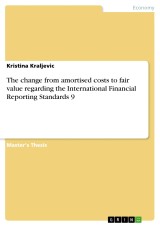Details

The change from amortised costs to fair value regarding the International Financial Reporting Standards 9
1. Auflage
|
36,99 € |
|
| Verlag: | Grin Verlag |
| Format: | |
| Veröffentl.: | 28.07.2020 |
| ISBN/EAN: | 9783346214409 |
| Sprache: | englisch |
| Anzahl Seiten: | 113 |
Dieses eBook erhalten Sie ohne Kopierschutz.
Beschreibungen
Master's Thesis from the year 2019 in the subject Economics - Finance, grade: 1, University of Applied Sciences Wiener Neustadt (Austria), language: English, abstract: This paper examines the adaption of the International Financial Reporting Standards 9, effective as of 1 January 2018. The introduction outlines the reasons for the amendments and the objectives of IFRS 9 which are divided into three phases. The focus of this paper is the effect of IFRS 9 on financial liabilities. While the International Accounting Standards 39 for financial liabilities are still accurate, IFRS 9 lead to a change in the fair value option. As a result, changes in the fair value which are caused by the own credit risk are booked into the other comprehensive income.
This paper aims to give an overview on the relevant changes regarding IFRS 9. However, the main focus is set at the liabilities side, the classification and the measurement of financial liabilities. Although the IASB intended to create a model in order to classify financial instruments of both the asset and the liabilities side, it had to prioritise the asset side owing to the financial crisis and the demand for new regulations in 2009. Therefore, the research context considers the adjustment of the fair value option (FVO) treatment. Due to the new regulation, changes in the own credit spread or rather the creditworthiness need to be captured under the position “other comprehensive income” (OCI), which affects the net income. Unless the financial liability is designated as FVO, the subsequent measurement of the liability follows amortised cost.
However, choosing the FVO implies that once the change in the credit spread has been recorded under the OCI, the amount is not reclassified into the profit-and-loss account (P & L). In contrast to that, a reclassification is permitted within equity e.g. a financial liability designated at FVO that is derecognised. The reason for the new regulation is based on IAS 39 and the measurement of liabilities in regard to the credit spread. Although, the creditworthiness deteriorated during the financial crisis, financial institutions had to realise the increasing credit spread in the P & L as an earning and a decreasing fair value (FV) of the liability. This mixed-model approach is a reason for the volatility in P & L’s and has been revised in the course of the IFRS 9.
This paper aims to give an overview on the relevant changes regarding IFRS 9. However, the main focus is set at the liabilities side, the classification and the measurement of financial liabilities. Although the IASB intended to create a model in order to classify financial instruments of both the asset and the liabilities side, it had to prioritise the asset side owing to the financial crisis and the demand for new regulations in 2009. Therefore, the research context considers the adjustment of the fair value option (FVO) treatment. Due to the new regulation, changes in the own credit spread or rather the creditworthiness need to be captured under the position “other comprehensive income” (OCI), which affects the net income. Unless the financial liability is designated as FVO, the subsequent measurement of the liability follows amortised cost.
However, choosing the FVO implies that once the change in the credit spread has been recorded under the OCI, the amount is not reclassified into the profit-and-loss account (P & L). In contrast to that, a reclassification is permitted within equity e.g. a financial liability designated at FVO that is derecognised. The reason for the new regulation is based on IAS 39 and the measurement of liabilities in regard to the credit spread. Although, the creditworthiness deteriorated during the financial crisis, financial institutions had to realise the increasing credit spread in the P & L as an earning and a decreasing fair value (FV) of the liability. This mixed-model approach is a reason for the volatility in P & L’s and has been revised in the course of the IFRS 9.

















